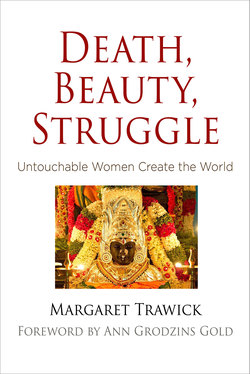Читать книгу Death, Beauty, Struggle - Margaret Trawick - Страница 8
На сайте Литреса книга снята с продажи.
ОглавлениеPreface
The fieldwork that resulted in this book was done intermittently from 1975 to 1991 while I was engaged in other projects in Tamil Nadu. The study for the book and the writing of it have been done continuously until now. Emergent from this work has been, among other things, a picture of how the government of India, and the British colonial government before it, tried to freeze groups of people in particular times, places, and occupations. Some are categorized as “Backward.” Others categorize themselves as “Forward.” Others are considered untouchable and categorized as “Scheduled Castes” or “Scheduled Tribes.” All the castes are ranked against each other. This ranking developed in parts of India millennia ago through a long and slow process. But real time has disrupted such categories. What has changed quickly, what has changed slowly, how the life of one or another person or group has been broken by change, how one or another person or group has adapted to change, how valuable the work of memory is, and how damaging old moralities are—these are realities unsought but uncovered in this book.
Anthropology, my chosen discipline, the study of humanity, has a long history and has been through many changes, from ancient days until now. This book presents bits of that history in India, from poems and organized treatises created millennia ago, to accounts from the nineteenth century, to ethnography from the late twentieth century, to articles and books from the twenty-first. Some of these have been created by Tamil people who did not think in terms of anthropology or history but more in terms of poetry and song. Later works have been composed by journalists, authors, filmmakers, artists, poets.
Most of my life, whether in the field or reading and writing, I did not think much about caste or gender or systems of rank. All of those were boring to me. So was politics. But now I cannot avoid such topics. The focus of these chapters is not on caste and gender oppression, important as these issues are to Indian society, but on the verbal art of the oppressed. These were people I thought of as normal. This book is about human beings as they describe and express their own lives and the lives of others in narrative, song, and conversation. Although individuals are important, relationships are more so. Caste, gender, and familial relationships, though rarely mentioned in song or speech, constitute an important feature of each of these women’s lived environments. In the larger view, caste, gender, familial, religious, and ethnic hierarchies in India cannot be ignored. This book shows clearly that nonliterate people living in the most abject circumstances, women of untouchable castes, may be the intellectual equals of great scholars far away from India. Caste is not overlooked, but it is seen in this book mostly through the eyes of Dalit women, or more precisely, through their voices.
